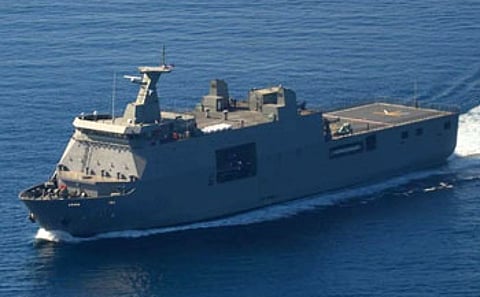

The Philippine Navy has commissioned four vessels into the Sealift Amphibious Force (SAF), a flotilla of ships whose main function is rapid deployment of ground combat elements – mainly those of the Philippine Marine Corps – and their supporting units to coastal areas.
As the Philippines is an archipelagic state of more than 7,100 islands, the navy's SAF is seen as one of the keys to ensuring territorial sovereignty and strengthening internal security.
With the greater availability of amphibious transport ships, it is now easier for the navy to deploy a sizable ground force to virtually any trouble spot in the country. These vessels are also regarded by some observers as force multipliers as they can be configured for humanitarian and disaster relief operations as well as search and rescue.
Of the four newly commissioned vessels, the largest and most prominent is the 'BRP Tarlac', named after a province in the Northern Philippines.
Launched on January 18, 2016, 'Tarlac' is a variant of the Makassar-class amphibious transport dock (LPD) originally built for the Indonesian Navy by PAL Indonesia and South Korea's Daesun Shipbuilding and Engineering Company.
'Tarlac's' commissioning also makes her the largest vessel currently in active service with the Philippine Navy at 123 metres in length and 7,200 gross tonnes in displacement. She is expected to be joined the following year by an as-yet-unnamed LPD of similar class, which is currently under construction at PAL's Surabaya shipyard.
In addition to having accommodations for a battalion of 300 to 500 troops and their associated vehicles and equipment, 'Tarlac' is also equipped with aviation support facilities for use with the navy's recently acquired AgustaWestland AW109 SAR/utility/light attack helicopters.
The three smaller vessels recently commissioned into the SAF are three heavy landing craft (LCH) that were acquired from Australia earlier this year – 'BRP Waray' (ex-HMAS 'Wewak'), 'BRP Iwak' (ex-HMAS 'Betano'), and 'BRP Agta' (ex-HMAS 'Balikpapan').
These three LCHs join two of their Balikpapan-class sister ships which were also acquired by the Philippines in 2015: 'BRP Ivatan' (ex-'HMAS Brunei') and 'BRP Batak' (ex-'HMAS Tarakan'). All 5 LCHs have been renamed after ethnic Filipino tribes.
The Philippine Navy has had amphibious warfare/support ships in its inventory beginning with the acquisition of US-built tank landing ships (LSTs) in the early post-World War II years.
However, the recent addition of ships to the SAF highlights the service's commitment to guaranteeing rapid deployment of ground combat personnel and materiel or humanitarian aid wherever needed throughout the archipelago.
Nelson E. Dela Cruz
